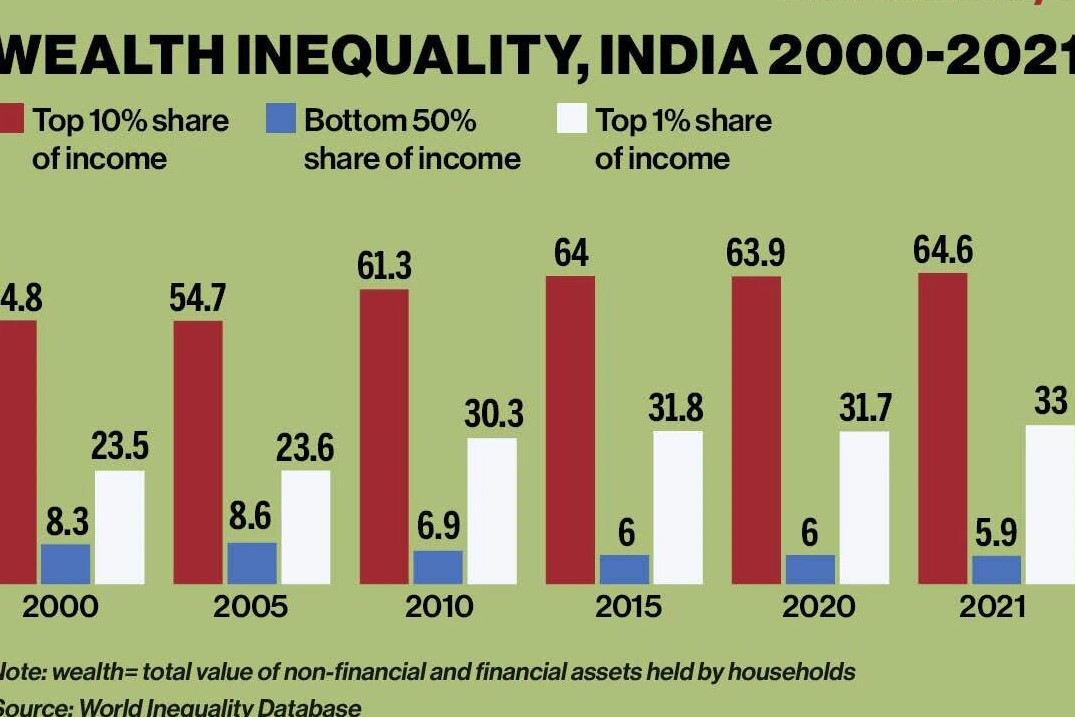
The World Inequality Report 2022, released recently, has brought out certain very important aspects about India which were although known to many of us but we preferred to shove them under the carpet, as we Indians love to live in DENIAL MODE.
The World Inequality report is brought out by the World Inequality Lab which is a research laboratory focusing on the study of inequality world wide. The Lab is composed of about forty people: co-directors, coordinators, research fellows, research assistants. It is hosted at the Paris School of Economics and the University of Berkeley, California. The World Inequality Lab works in close coordination with the large international world inequality Database network. The World Inequality Database (WID.world) relies on the combined effort of an international network of over a hundred researchers covering more than seventy countries from all continents.
Thus those who wish to see the facts and also comprehend what it actually means and what can be its future implications can take the pains to read the article and the rest can continue to live in illusion ; MODI HAI TO MUMKIN HAI.
The major highlights of the report are ;
- Nobel laureate economists Abhijit Banerjee and Esther Duflo in the preface of the report say that India is "among the most unequal countries in the world.
- "The top 1 per cent took 38 per cent of all additional wealth accumulated since the mid-1990s, with acceleration since 2020. No wonder in last three years Adanis have grown their wealth manifolds.
- The top 1 per cent of Indians now own 33% of the country's wealth compared to 31.7 per cent previously. The top 10 per cent own 64.6 per cent of the country's wealth, up from 63.9 per cent. The share of the bottom 50 per cent now stands at 5.9 per cent, down from 6 per cent earlier. The average household wealth in India stands at Rs 9,83,010. The bottom 50 per cent owns an average wealth of Rs 66,280/ which is virtually nothing.So, now we know why few business houses have their presence everywhere and enjoy monopoly in Business ; TATAs have ; TCS, TANISHQ(Jwellery), Watches, STEEL, Hotels, Aviation, Mobile communication, Automobiles , Chemicals etc. Reliance has ; Petrochemicals, Retail, Communication, Infrastructure, Def manufacturing, etc. Adanis ; Power, Ports, mining etc. Birlas …
- India's female labour income share of 18 per cent in 2021 was one of the lowest in the world.
- The report also highlighted that the quality of inequality data released by the Indian government has "seriously deteriorated" over the past three years. The Indian Govt has not been releasing any data for almost last 3-4 years and the data that is released by any other agency is quickly disapproved by the Govt. So, no one knows , what is the state of economy.
If the above has been reported by a reputed agency , then the first thing that we must do is - Accept that everything is not hunky dory with the nation and if things do not fall in place soon the implications can be severe.
Although some of us may ask what is so new about it, what difference does it make if the top 10% is now managing a percentage extra, India has always been like this since many decades . therefore, Inorder to comprehend the full implications of it we need to look at following ;
The first thing that happens in such an UNEQUAL SOCIETY is that Rich keep growing richer and poor keep becoming poorer. So, in last three years the rich have accumulated huge wealth and corona has further accelerated that process.
Two. Inequality can lead to numerous challenges that can lead a nation towards disastrous consequences.
- INEQUALITY is one of the main drivers of social tension., which can lead to LAW AND ORDER PROBLEMS.
- It will pose a challenge to the eradication of extreme poverty.
- World bank and many such agencies have agreed that inequality tends to reduce the pace of growth and durability of growth.
- The Research by the World Bank indicates that when markets are imperfect that is, if it does not provide equal opportunities in terms of credit, insurance, land and human capital, it leads towards inequalities in power and wealth that would further enhance the INEQUALITY in terms of opportunities.
- Unequal power also leads to the formation of institutions that will further aggravate the inequalities in power, status, and wealth, which are also bad for the investment, innovation, and risk-taking that can have an impact on long-term growth
- Recent research done by World Bank suggests that. Inequalities have also been found to undermine social cohesion.
Four . For a layman, the above means, that the affluent ; Political class, the Bureaucracy, the Rich and the Police and off course the judiciary will operate hand in glove and the entire administrative machinery will be at their back and call . The common man would find it difficult to get justice. For instance the Minister’s son who crushed the farmers under his SUV is now out on bail and we should not be surprised that he will be acquitted of all charges .We have already witnessed How Salman Khan got away from the clutches of law. In short the rich and affluent will be able to buy justice. India will become a Matsaya Rajya ; i.e where the Big fish eats the small fish.
Inview of the above, and as things stand today in terms of law and order, the communal situation , the overall mis Governance and in effectiveness of various institutions, the Govt must take a HOLISTIC view of entire gamut of aspects that lead to INEQUALITY and address them as per a concerted plan of action, instead of encouraging social strife.
